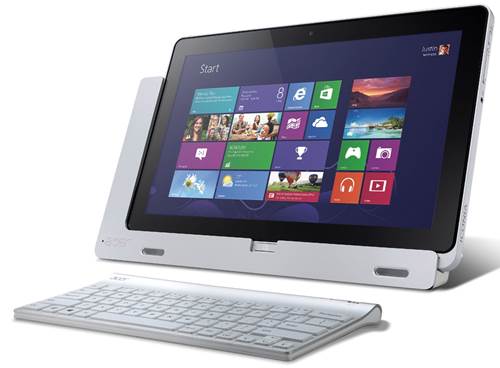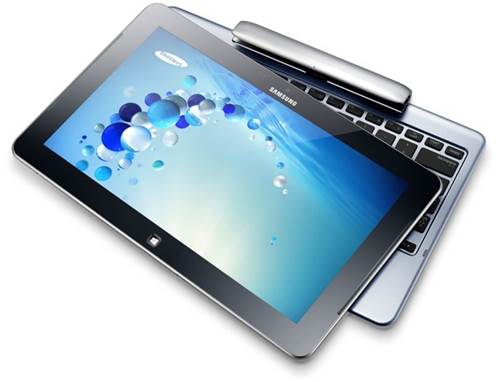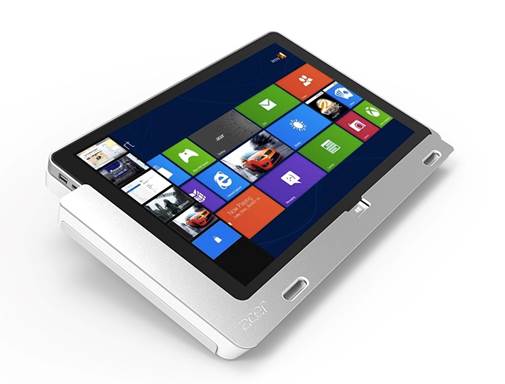The recently launched windows 8 OS ushered
in a new era of mobile computing. Acer, ASUS, and Samsung were among the first
to locally roll out their tablets based on this touch-centric platform. How do
they fare? Let’s find out.
Acer Iconia W700
Acer made waves in the tech industry with
the introduction of its Windows 8-equipped lineup, spearheaded by its flagship
Ultrabook, the Aspire S7. The iconia W700follows in its footsteps, except it
comes in a more portable tablet form factor.

Acer
Iconia W700
With Windows 8 as its one and only
operating system, mobile productivity and entertainment is a sure deal. On the
outside, the Iconia W700 is definitely a solid slate with its full aluminum
body which has a solid build and premium feel. In turn, this 11.6-inch device
leans a bit on the heavy side at 1043g. It also isn’t as thin as the other
tablets with its 11.9mm thickness. However, it makes up for it by having specs
beyond its price point, referring to its Intel Core i3-3217U 1.8GHz processor.
Thanks to the Intel Core processor, you get
USB 3.0 support right out of the box. Its lone USB 3.0 port can then become
three USB ports via the included dock. Another feature you’ll get with the
third-generation Intel Core processor is a capable internal GPU in the form of
Intel’s HD 4000 Graphics. For better viewing, a micro-HDMI is available if you
wish to outsource your display to a larger screen.
In general, you won’t have to worry about
performance issues as you can multitask and quickly switch between apps without
any serious lag. Yet, the processing power of the Core i3-3217U comes at a
price, as the tablet heats up during long use, and the battery life is
shortened by the increased power consumption.
The Full HD 1080p display of the Iconia
W700 brings out amazing picture quality. The IPS technology used provides great
viewing angles, eye-catching color quality, and a bright display. Still, having
a Full HD display also has its drawbacks, requiring additional power and
draining the battery even more. As for the camera, you get a 5-megapixel main
shooter and a 1.2-megapixel front-facing camera capable of 1080p and 720p
recording, respectively.
Acer’s 11.6-inch tablet is targeted towards
users who are looking for a capable mobile workstation. Its Ultrabook like
specifications gives it more than enough computing power to drive up
power-hungry programs like Adobe Photoshop. With the included dock, it can act
as a mini workstation, since you get access to three USB 3.0 ports for an extra
mouse and keyboard, on top of the touch capability. Battery endurance is also
much closer to a notebook rather than a tablet, as the Iconia W700 lasts up to
five hours with continuous moderate usage.
ASUS ViVotab
Anyone familiar with the Transformer Pad
Infinity T700 will feel a sense of nostalgia when taking a glance at the ASUS
vivoTab. Yet despite the similar looks, this tablet instead takes full
advantage of Windows 8.

ASUS
ViVotab
The ViVoTab is a highly portable tablet,
featuring ASUS’s well-known and attractive metallic design taken from its
ZenBook and Transformer Pad series. The ViVoTab comes in an aluminum body and
has an 11.6-inch display covered by Corning Fit Glass for improved scratch
resistance. Adding to the excellent physique is its thin and light body that measures
8.7mm and weighs only 675g. For added connectivity, it comes with a microSD
card reader, micro-HDMI, and a 2-in-1 audio jack.
The unit is powered by an Intel Atom Z2760
clocked at 1.8GHz, which enables the tablet to multitask with lightweight applications.
Being an Atom processor, it doesn’t get that hot and can sustain longer uptimes
compared to the Acer tablet. Missing the traditional keyboard and touchpad
combo? Fret not, as the VivoTab comes with a mobile dock. Not only does it
feature a keyboard and touchpad, it also adds two USB 2.0 ports, as well as
additional battery power. If you prefer the pen experience, you can make use of
its bundLED Wacom Digitizer stylus.
Moving on to the multimedia side, the
VivoTab’s Super IPS+ display provides ultra-wide viewing angles and incredibly
bright, vibrant colors. The 1366 x 768-pixel resolution is certainly enough for
most multimedia needs on an 11.6-inch form factor. As for speakers, you get
four (two on the tablet and two on the dock) with Sonic Master audio
technology.
Capturing great photos is another pleasure
due its main 8-megapixel autofocus camera and built-in LED flash. As for
shooting videos, you get 1080p recording that captures at approximately 30
frames per second.
The VivoTab is good for entertainment while
still leaving room for productivity. One minor gripe is that the audio lacks
power when not docked, as it loses two of its four speakers. Using the tablet
in portrait mode can also be a bit uncomfortable for some, as it feels too tall
and narrow. Still, It handles very well if you use two hands during landscape
mode – one holding the tablet and the other using the on-screen keyboard. As
for its longevity, typical usage leads up to seven hours (435 minutes) without
the dock. With the dock, you can expect double the amount, which is great
during long trips.
Samsung ATIV Smart PC
Like the ASUS offering, the Samsung ATIV
smart Pc takes a page from its Android tablet siblings in terms of aesthetic
looks and the bund LED stylus. The difference, however, is the integration of
Windows 8, effectively combining the power of a notebook and the convenience of
a tablet.

The
ATIV Smart PC is powered by an Intel Atom Z2760.
The ATIV Smart PC looks and feels like a
Galaxy Note 10.1, except this Windows 8-equipped tablet has a larger 11.6-inch
display. Due to its plastic body, it remains lightweight and portable at 744g.
It’s almost as thin as the VivoTab, coming in at 9.9mm. For connectivity, it
has USB 2.0 and micro-HDMI ports, a microSD card reader, and a 2-in-1 audio
jack.
The ATIV Smart PC is powered by an Intel
Atom Z2760. Thanks to this, the tablet can easily handle simple multitasking
and won’t get that hot while doing so.
Productivity and entertainment go
hand-in-hand with the ATIV Smart PC. The packaged keyboard dock transforms it
into a capable notebook for typing, while the S Pen stylus and S Note software
work great for quick note-taking. Of course, all your trusty Windows
productivity applications such as MS Word and excel, are all natively supported
on its Windows 8 OS.
Its 11.6-inch capacitive touch display has
a pixel resolution of 1366 x 768, which is just right for the screen size, in
our opinion. Thanks to the Super PLS technology used on the LCD, it has a
brighter display compared to the VivoTab. Superb viewing angles and accurate
colors are other contributing factors to the strengths of the Samsung screen.
The two speakers are conveniently located on the front and provide enough power
even in an open environment. The 8-megapixel camera with LED flash and 1080p
video recording is also readily available whenever you need it.
The Samsung ATIV Smart PC will definitely
be popular among those who’re looking for a tablet which allows for lightweight
productivity. As for entertainment, it’s more than capable of extended play,
having a battery capacity that lasts more than seven hours (448 minutes). Like
the ASUS tablet, holding it in portrait mode felt a bit awkward due to its
overly narrow and long shape. But other than that, this tablet performed well
enough on all other fronts.
It’s also worth mentioning that this tablet
has a bigger brother, the ATIV Smart PC Pro, which is built for power users who
need a better CPU for speedier performance and heavier workloads.
And The Best Windows 8 Tablets Are...
Acer Iconia W700
Pound-for-pound, the Acer Iconia W700 is
definitely the best among the three Windows 8 tablets in terms of raw
performance. This relatively heavyweight tablet is the obvious choice for those
looking for better compute performance than most tablets available today, due
primarily to its Intel core i3-3217uprocessor. in addition, its dock allows for
greater connectivity and convenient use on a table, essentially turning the
tablet into a mini workstation wherever you bring it.

Pound-for-pound,
the Acer Iconia W700 is definitely the best among the three Windows 8 tablets
in terms of raw performance.
With an $980, you can’t go wrong with the
Acer offering. You’ll surely get your money’s worth in terms of performance and
a solid build quality.
Samsung ATIV Smart PC
Priced at $884, the Samsung ATIV smart Pics
the least expensive of the three tablets that we tested. However, the lower
price doesn’t mean that Samsung left out some features or downgraded the
tablet’s overall performance.
For the price, you get a fully functional
slate with enough performance to multitask between lightweight apps on its
Intel atom Z2760.The 11.6-inch display also happens to be the brightest of the
ones we tested and comes with great viewing angles, add a keyboard dock and
Samsung’s sPen to the mix, on top of its already great value, and you get the
best possible deal.
ASUS ViVotab
The ASUS ViVoTab might not be the best in
terms of performance nor value, but it’s still a viable option in other
aspects. its aluminum body and great finish make it the most attractive of the
bunch. in our imaging tests, the ViVoTab’s rear camera came out on top. it
produced the most impressive shots in both indoor and outdoor environments,
displaying good dynamic range and sharp details. You also get a handy keyboard
dock and digitizer stylus in the package.
You’d have to shell out $1,056 for the
ViVoTab, which makes it the priciest in the group. But for the premium build
and top-notch camera, it’s hard to go wrong with this offering either.